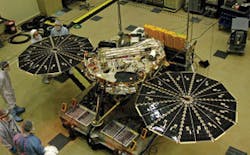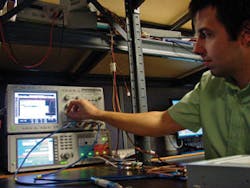By Courtney E. Howard
WASHINGTON - NASA engineers readied the Phoenix Mars Lander for a mission to Mars’s arctic landscape with an array of advanced electronics. These research tools, never used on Mars before, will aid in NASA’s first exploration of a potential Martian habitat.
The Phoenix Mars Lander lifted off aboard a three-stage Delta II launch vehicle from Cape Canaveral Air Force Station in Florida on the morning of Aug. 3, the start of a three-week launch period. After traveling 171 million miles from Earth, Phoenix must survive a powered descent and landing on near the north polar permanent ice cap of Mars next spring and conduct a three-month mission.
“Phoenix will complement our strategic exploration of Mars by being our first attempt to actually touch and analyze Martian water-water in the form of buried ice,” says Doug McCuistion, director of the Mars Exploration Program at NASA Headquarters in Washington.
With its 7.7-foot-long, aluminum and titanium robotic arm, the Phoenix Mars Lander will dig down into the Red Planet’s frozen soil. A camera and conductivity probe on the arm will gather imagery and soil and ice samples, which will be analyzed with instruments onboard the lander’s deck. A team at NASA’s Jet Propulsion Laboratory (JPL), a division of the California Institute of Technology in Pasadena, Calif., engineered and tested the Phoenix robotic arm, which was built by engineers at Alliance Spacesystems Inc. in Pasadena.
Fastened to the arm is a camera with a double Gauss lens system that will provide close-up color images of Martian soil at the landing site, of the floor and walls of trenches dug by the arm, and of soil and ice samples. The camera employs a charge-coupled device (CCD) to record imagery, and sets of red, green, and blue light-emitting diodes (LEDs) for illuminating the target area. Users can adjust the camera’s focus using a motor-a first for a camera on an interplanetary spacecraft. A team at the Max Planck Institute for Solar System Research in Katlenburg-Lindau, Germany, and at the University of Arizona originally built the camera for the Mars Surveyor 2001 Lander mission, which was canceled in 2000.
The craft’s meteorological station includes a 4-foot mast sporting temperature and pressure sensors at three heights, as well as a laser-reflection instrument called a lidar (light detection and ranging). The lidar emits laser pulses into the atmosphere and detects light reflected off of atmospheric dust and ice particles in the beam’s path. Weather also is monitored with temperature sensors, thin-wire thermocouples using the metals chromel (a nickel and chromium alloy) and constantan (a copper and nickel alloy). The Canadian Space Agency, with help from scientists at York University in Toronto, provided the meteorological station. Instrument construction was led by the Space Missions Group of MDA Ltd., Brampton, Ontario, with contributions from Optech Inc., Toronto, for the lidar. The Finnish Meteorological Institute provided the instrument for measuring atmospheric pressure.
A surface stereoscopic imager, with twin cameras having the same resolution and spacing as human eyes, also is situated atop the lander’s mast, 7 feet above ground level. The imager can record three-dimensional, panoramic information of the surroundings on its two 1-megapixel (1024-by-1024-pixel resolution) CCDs. Twelve individual filters enables the production of images in full color and in several specific visual and infrared frequencies. A University of Arizona team built the Phoenix surface stereoscopic imager.
A Thermal and Evolved-Gas Analyzer-built by teams at the University of Arizona and the University of Texas, Dallas-uses a differential scanning calorimeter and a mass spectrometer to study samples. A Microscopy, Electrochemistry and Conductivity Analyzer examines soil with two types of microscopes and a wet chemistry laboratory with four beakers. The inner surfaces of each beaker house 26 sensors behind permeable membranes or gels to provide information about the soil. A team at JPL designed and built the analyzer.
The Mars Descent Imager-using a camera with a one-pound imager and optics with a 75.3-degree field of view-is mounted on the outer edge of the lander’s payload deck to take downward-facing images during descent and landing. The Mars Descent Imager was originally built for the Mars Surveyor 2001 Lander mission by a team at Malin Space Science Systems, San Diego.
Phoenix will rely on energy stored in a pair of rechargeable 25-amp-hour, lithium-ion batteries until its solar arrays are opened, roughly 15 minutes after touchdown. The two-wing solar array-shaped like two circular decagons with 45-square-foot surface area that extend from opposite sides of the lander-uses photovoltaic cells to convert solar radiation to electricity.
The spacecraft’s command and data handling subsystem takes advantage of 74 megabytes of random access memory (RAM), flash memory, and a RAD6000 microprocessor modified to withstand radiation, temperature fluctuations, and other environmental challenges. In fact, the spacecraft’s thermal control subsystem combines electrical heaters, thermostats, and temperature sensors to prevent component damage during periods of high heat en route to Mars, severe cold at the Martian Arctic Circle, and daily temperature variations. A UHF antenna on the lander deck provides communications and data transmissions.
The Phoenix Mars Lander project is led by principal investigator Peter Smith of the University of Arizona, Tucson, and managed by NASA’s Jet Propulsion Laboratory. The Mars Program is managed by the Science Mission Directorate at NASA Headquarters in Washington.
The spacecraft was built by engineers at Lockheed Martin Space Systems, the prime contractor for the project, in Denver, with Edward Sedivy serving as Phoenix program manager. Lockheed Martin’s staff shares in the operation of Phoenix with JPL. The High Resolution Imaging Science Experiment is operated by the University of Arizona, Tucson, and the instrument was built by Ball Aerospace and Technology Corp. in Boulder, Colo.
Phoenix also benefits from international contributions provided by the Canadian Space Agency; the University of Neuchatel, Switzerland; the University of Copenhagen, Denmark; the Max Planck Institute, Germany; and the Finnish Meteorological Institute.
Additional information on the Phoenix mission is available online at http://www.nasa.gov/phoenix.





